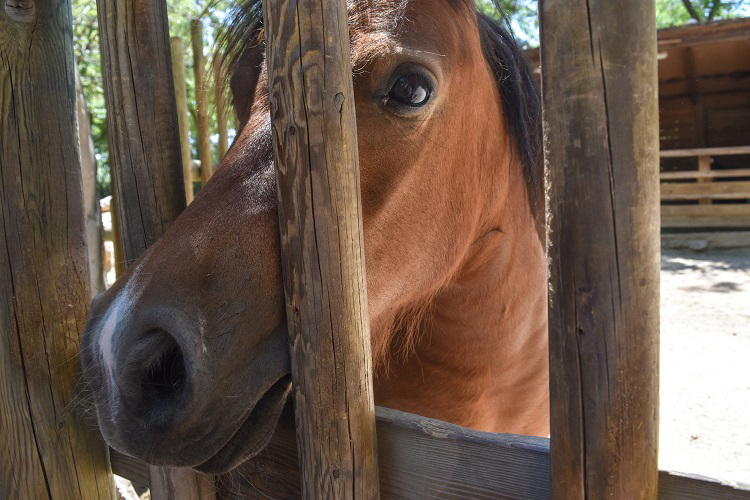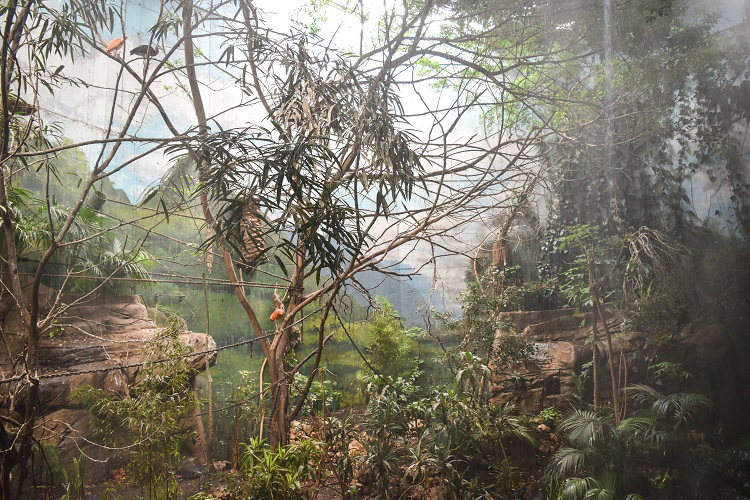MADRID – Many tourists find a way to a local park to skip the rustle and bustle of Madrid’s busy streets. But for the animal-loving travelers, there is an unusual place not far from the city center, a nature park named Faunia. Unlike a zoo, each animal’s habitat is completely recreated to match their wild side. You can see a baby-faced wallaby in the Australian Territory and even get close enough to stroke it! Featuring 500 species of animals and 15,000 plants from ecosystems around the world, Faunia opens your eyes to the vastness of nature.

A miniature horse searches for attention and a snack at La Granja (The Farm) | Cheyenne Trautman
I personally have a lifetime experience with animals. Growing up with a veterinarian as my mother, I have learned the essentials to having happy and healthy animals. Yes, I do not know too much about wild animals such as seals or bats. But I do understand the necessity of allowing dogs, cats, horses, goats, rabbits, hamsters, chickens, and mini pigs to have space to run and play. Room to express their personalities, proper diets, and activities is required to having a healthy life. If animals receive poor food and/or are limited in activity, they become malnourished and thus, depressed. Having visited many zoos, I have seen several creatures restricted to compounds with barely enough room to stretch their legs. It breaks my heart. On the other hand, I had heard so much about Faunia Nature Park located in Madrid. I had heard statements about how the animals have more freedom and healthier enrichments. It drew my curiousity, so I decided to visit this park myself.
Just entering the park lightens your mood as upbeat tunes hum in your ears, birds sing gleefully up in the trees, and ducks and geese follow your every step (looking for a snack). You could start visiting La Granja (The Farm) which is the first right, then work counter-clockwise around the park. Or do what I did, to skip The Farm (I saved it for last) and visit the capuchin monkeys hanging around (literally and figuratively) their wooden and rope gymnasium above the lake. It was quite a show seeing these brown monkeys swing and climb about their habitat. You could stay there all day, but remember that there are plenty of other animals to see.

A rainstorm gusts at full force in the Jungla (Jungle) Ecosystem | Cheyenne Trautman
Within minutes of strolling along the pathway, you find yourself entering the Mangrove Crocodile exhibit. Filled with overflowing vines, lush ferns, and tall mangrove trees, you will also find the crocodiles and fish native to this humid environment. This exhibit is the perfect example of all the recreated habitats in which Faunia earns its reputation. From its plants to the blistering humidity, this habitat is flawlessly built for the animals in this ecosystem. Faunia continues to amaze me as I make my way towards the Jungle exhibit. Once you enter, the sounds, smells, and sights of the authentic jungle overwhelms you. You hear toucans having conversations and sense the coming of rain. Faunia went so as far as to create a rain storm on demand inside this exhibit (you are under a canopy, but you might still get drizzled on) to simulate the jungle’s weather. Do not pass the opportunity to tour the closed-off area where macaws and squirrel monkeys roam about your feet! Unfortunately, you cannot touch or take pictures of any animals in this area. But, you do get the chance to have face-to-face interactions with these humorous creatures as tourist Danielle Smith puts it, “It was really fun to be so close to them. Being that close really allows you to connect with them and understand them.” There are many opportunities to get close interactions with a variety of animals at the park. Be aware however, there are some that will likely startle you if you are not paying attention! Such as the emu, a large flightless bird, located at the Australian Territory. He is always looking for something to snatch out of your hands.

A lionfish swims comfortably in a large tank found in the Veneno (Venom) exhibit | Cheyenne Trautman
Faunia has many species from all over the world. But I wondered if they had any native species to Spain. Beatriz Navarro, who works at the park gift shop, had the answer. “The animals we have are all imported. The ducks are native, but that is it,” she comments. Even though Faunia hardly features any native “Spaniards,” it still has animals that are “not as common,” as Navarro states. Instead of the more common animals such as giraffes, elephants, and tigers found at many zoos, Faunia introduces the planet’s most exotic creatures like my personal favorite, the red panda. Before leaving the park, make sure to stop by La Granja where miniature horse, goats, sheep, pigs, and chickens are waiting for attention (and food of course).
Madrid’s Faunia Nature Park is off the grid as you might say. It is not the first activity listed on sightseeing websites. However, Faunia gives Madrid tourists and locals a place to go relax and visit some cute critters. From the lazy manatees to the high energy of the ring-tailed lemurs, Faunia is a place that should not be overlooked.
Faunia Nature Park
Avenida de las Comunidades 28, 28032 Madrid, Spain. The closest metro is Valdebernardo. The walk from the metro is about 15 minutes. Once you exit the train, look for a green sign that points you in the direction of “parque de naturalza”. When you get outside, you should see a street to your right called Calle Pinillas. Take this street and turn right onto Cordel de Pavones. At the end of the block you will see a large commercial building on your left. Turn left, keeping the building on your left. At the end of the road, at the roundabout, you will see a small orange sign pointing across the street. Follow the sign and you should see a billboard to your right with a seal and saying “Faunia.” Go towards this sign then you should see the Faunia Nature Park entrance in the distance.
Phone Number: +34 90 253 5545
Hours: January-February open only weekends. The rest of the year, opening times change monthly but mainly it’s open weekdays and weekends 10:30am-7:00pm
Cost: Adults: €26.45s ($30.49) The website www.faunia.es offers ticket discounts.
Travel Journalism, Photography & Video Internship Seminar in Madrid, Spain

